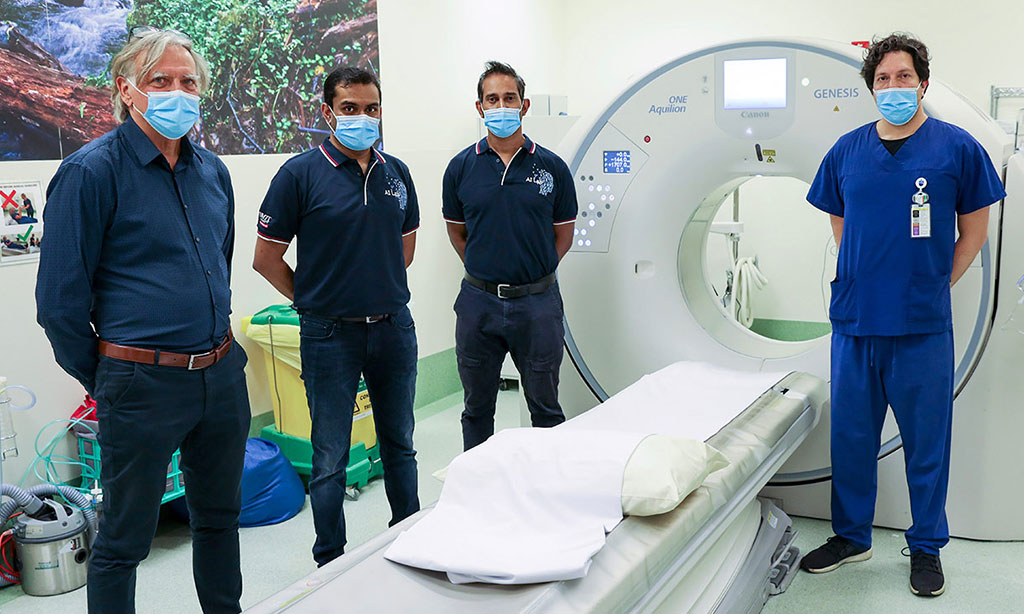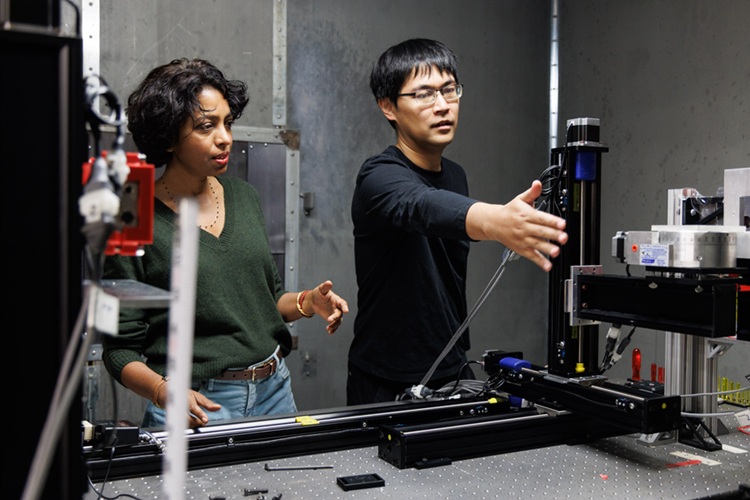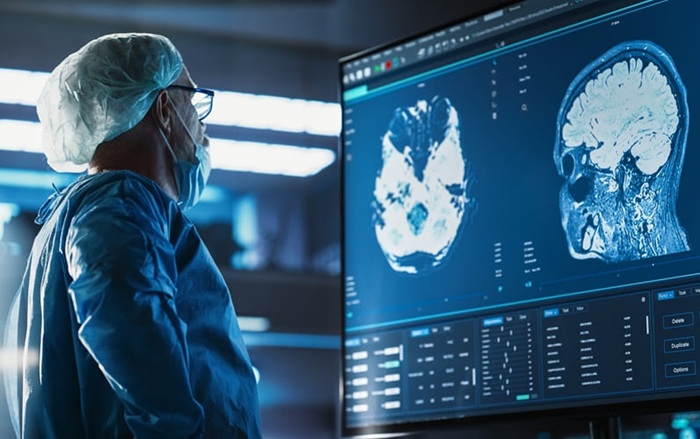AI Diagnostic Tool Analyzes CT Scans to Spot Prostate Cancer Before Patients Have Symptoms
|
By MedImaging International staff writers Posted on 13 Jul 2021 |

Image: AI Diagnostic Tool Analyzes CT Scans to Spot Prostate Cancer Before Patients Have Symptoms (Photo courtesy of RMIT University)
Researchers have developed a diagnostic tool that can spot prostate cancer before patients have any symptoms, using artificial intelligence to analyze Computed Tomography (CT) scans in just seconds.
Researchers at RMIT University (Melbourne, Australia), in collaboration with clinicians at St Vincent’s Hospital Melbourne (Australia), have developed an artificial intelligence (AI) program that could catch the prostate cancer earlier, allowing for incidental detection through routine CT scans. The technology works by analyzing CT scans for tell-tale signs of prostate cancer, something even a well-trained human eye struggles to do.
Prostate cancer is the most diagnosed cancer and is slow growing, usually detected incidentally due to which it can go undiagnosed for years. It was responsible for an estimated 12% of male cancer deaths in 2020. Early detection is the key to successful treatment but men often dodge the doctor, avoiding diagnosis tests until it’s too late. CT imaging is not suitable for regular cancer screening because of the high radiation doses involved. CT scans were great for detecting bone and joint problems but even radiologists struggled to spot prostate cancers on the images. The new AI solution can be used to run a cancer check whenever men have their abdomen or pelvis scanned for other issues.
For the study, the researchers studied CT scans of asymptomatic patients, with and without prostate cancer. The team trained the AI software to look for features of disease in a variety of scans and where exactly to look for them, avoiding the need to manually crop the images. The AI performed better than radiologists who viewed the same images, detecting cancerous growths in just seconds. What’s more, the AI improved with each scan, learning and adapting to read images from different machines to spot even the smallest irregularities. The technology can be applied at scale, potentially integrating with a variety of diagnostic imaging equipment like MRI and DEXA machines - pending further research.
“We’ve trained our software to see what the human eye can’t, with the aim of spotting prostate cancer through incidental detection,” said RMIT’s Dr. Ruwan Tennakoon. “It’s like training a sniffer dog – we can teach the AI to see things that we can't with our own eyes, in the same way a dog can smell things human noses can’t.”
Related Links:
RMIT University
St Vincent’s Hospital Melbourne
Researchers at RMIT University (Melbourne, Australia), in collaboration with clinicians at St Vincent’s Hospital Melbourne (Australia), have developed an artificial intelligence (AI) program that could catch the prostate cancer earlier, allowing for incidental detection through routine CT scans. The technology works by analyzing CT scans for tell-tale signs of prostate cancer, something even a well-trained human eye struggles to do.
Prostate cancer is the most diagnosed cancer and is slow growing, usually detected incidentally due to which it can go undiagnosed for years. It was responsible for an estimated 12% of male cancer deaths in 2020. Early detection is the key to successful treatment but men often dodge the doctor, avoiding diagnosis tests until it’s too late. CT imaging is not suitable for regular cancer screening because of the high radiation doses involved. CT scans were great for detecting bone and joint problems but even radiologists struggled to spot prostate cancers on the images. The new AI solution can be used to run a cancer check whenever men have their abdomen or pelvis scanned for other issues.
For the study, the researchers studied CT scans of asymptomatic patients, with and without prostate cancer. The team trained the AI software to look for features of disease in a variety of scans and where exactly to look for them, avoiding the need to manually crop the images. The AI performed better than radiologists who viewed the same images, detecting cancerous growths in just seconds. What’s more, the AI improved with each scan, learning and adapting to read images from different machines to spot even the smallest irregularities. The technology can be applied at scale, potentially integrating with a variety of diagnostic imaging equipment like MRI and DEXA machines - pending further research.
“We’ve trained our software to see what the human eye can’t, with the aim of spotting prostate cancer through incidental detection,” said RMIT’s Dr. Ruwan Tennakoon. “It’s like training a sniffer dog – we can teach the AI to see things that we can't with our own eyes, in the same way a dog can smell things human noses can’t.”
Related Links:
RMIT University
St Vincent’s Hospital Melbourne
Latest Industry News News
- GE HealthCare and NVIDIA Collaboration to Reimagine Diagnostic Imaging
- Patient-Specific 3D-Printed Phantoms Transform CT Imaging
- Siemens and Sectra Collaborate on Enhancing Radiology Workflows
- Bracco Diagnostics and ColoWatch Partner to Expand Availability CRC Screening Tests Using Virtual Colonoscopy
- Mindray Partners with TeleRay to Streamline Ultrasound Delivery
- Philips and Medtronic Partner on Stroke Care
- Siemens and Medtronic Enter into Global Partnership for Advancing Spine Care Imaging Technologies
- RSNA 2024 Technical Exhibits to Showcase Latest Advances in Radiology
- Bracco Collaborates with Arrayus on Microbubble-Assisted Focused Ultrasound Therapy for Pancreatic Cancer
- Innovative Collaboration to Enhance Ischemic Stroke Detection and Elevate Standards in Diagnostic Imaging
- RSNA 2024 Registration Opens
- Microsoft collaborates with Leading Academic Medical Systems to Advance AI in Medical Imaging
- GE HealthCare Acquires Intelligent Ultrasound Group’s Clinical Artificial Intelligence Business
- Bayer and Rad AI Collaborate on Expanding Use of Cutting Edge AI Radiology Operational Solutions
- Polish Med-Tech Company BrainScan to Expand Extensively into Foreign Markets
- Hologic Acquires UK-Based Breast Surgical Guidance Company Endomagnetics Ltd.
Channels
Radiography
view channel
AI Detects Early Signs of Aging from Chest X-Rays
Chronological age does not always reflect how fast the body is truly aging, and current biological age tests often rely on DNA-based markers that may miss early organ-level decline. Detecting subtle, age-related... Read more
X-Ray Breakthrough Captures Three Image-Contrast Types in Single Shot
Detecting early-stage cancer or subtle changes deep inside tissues has long challenged conventional X-ray systems, which rely only on how structures absorb radiation. This limitation keeps many microstructural... Read moreMRI
view channel
Novel Imaging Approach to Improve Treatment for Spinal Cord Injuries
Vascular dysfunction in the spinal cord contributes to multiple neurological conditions, including traumatic injuries and degenerative cervical myelopathy, where reduced blood flow can lead to progressive... Read more
AI-Assisted Model Enhances MRI Heart Scans
A cardiac MRI can reveal critical information about the heart’s function and any abnormalities, but traditional scans take 30 to 90 minutes and often suffer from poor image quality due to patient movement.... Read more
AI Model Outperforms Doctors at Identifying Patients Most At-Risk of Cardiac Arrest
Hypertrophic cardiomyopathy is one of the most common inherited heart conditions and a leading cause of sudden cardiac death in young individuals and athletes. While many patients live normal lives, some... Read moreUltrasound
view channel
Wearable Ultrasound Imaging System to Enable Real-Time Disease Monitoring
Chronic conditions such as hypertension and heart failure require close monitoring, yet today’s ultrasound imaging is largely confined to hospitals and short, episodic scans. This reactive model limits... Read more
Ultrasound Technique Visualizes Deep Blood Vessels in 3D Without Contrast Agents
Producing clear 3D images of deep blood vessels has long been difficult without relying on contrast agents, CT scans, or MRI. Standard ultrasound typically provides only 2D cross-sections, limiting clinicians’... Read moreNuclear Medicine
view channel
PET Imaging of Inflammation Predicts Recovery and Guides Therapy After Heart Attack
Acute myocardial infarction can trigger lasting heart damage, yet clinicians still lack reliable tools to identify which patients will regain function and which may develop heart failure.... Read more
Radiotheranostic Approach Detects, Kills and Reprograms Aggressive Cancers
Aggressive cancers such as osteosarcoma and glioblastoma often resist standard therapies, thrive in hostile tumor environments, and recur despite surgery, radiation, or chemotherapy. These tumors also... Read more
New Imaging Solution Improves Survival for Patients with Recurring Prostate Cancer
Detecting recurrent prostate cancer remains one of the most difficult challenges in oncology, as standard imaging methods such as bone scans and CT scans often fail to accurately locate small or early-stage tumors.... Read moreGeneral/Advanced Imaging
view channel
AI-Based Tool Accelerates Detection of Kidney Cancer
Diagnosing kidney cancer depends on computed tomography scans, often using contrast agents to reveal abnormalities in kidney structure. Tumors are not always searched for deliberately, as many scans are... Read more
New Algorithm Dramatically Speeds Up Stroke Detection Scans
When patients arrive at emergency rooms with stroke symptoms, clinicians must rapidly determine whether the cause is a blood clot or a brain bleed, as treatment decisions depend on this distinction.... Read moreImaging IT
view channel
New Google Cloud Medical Imaging Suite Makes Imaging Healthcare Data More Accessible
Medical imaging is a critical tool used to diagnose patients, and there are billions of medical images scanned globally each year. Imaging data accounts for about 90% of all healthcare data1 and, until... Read more





















